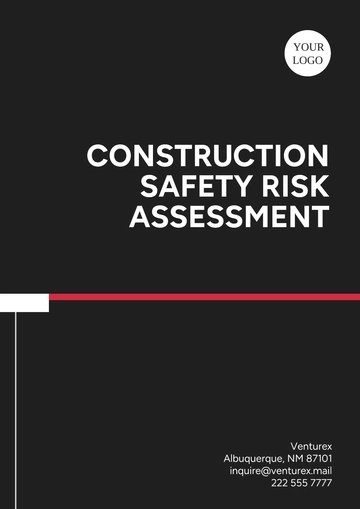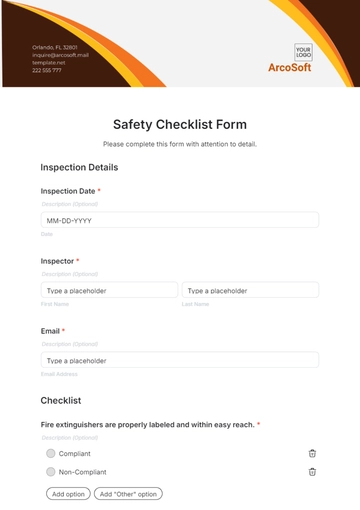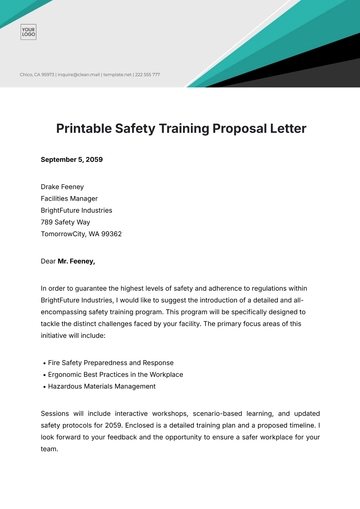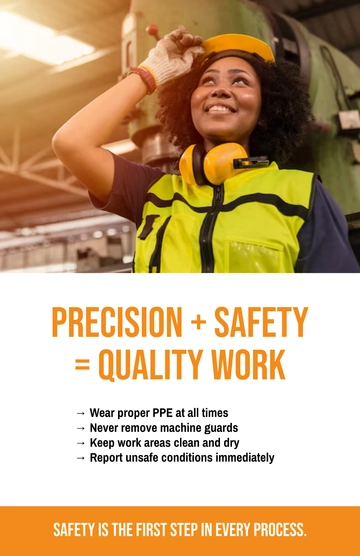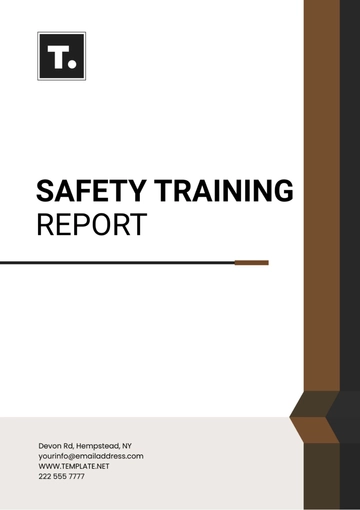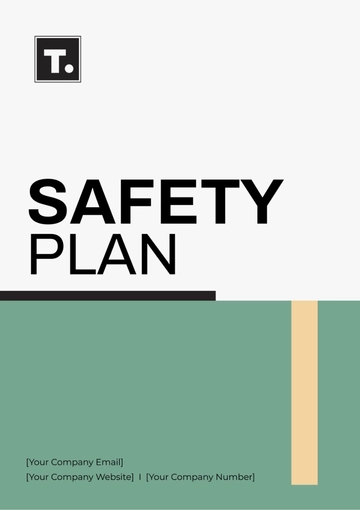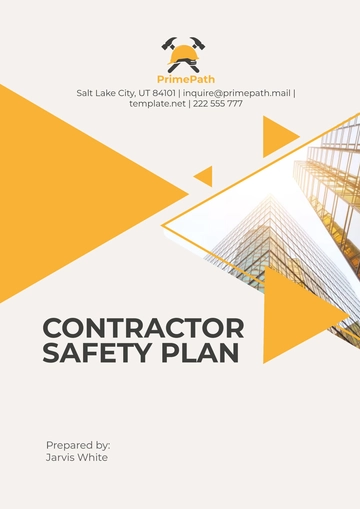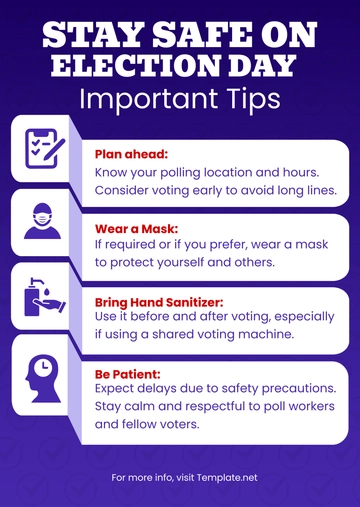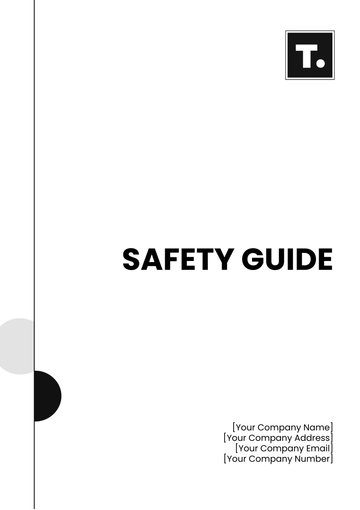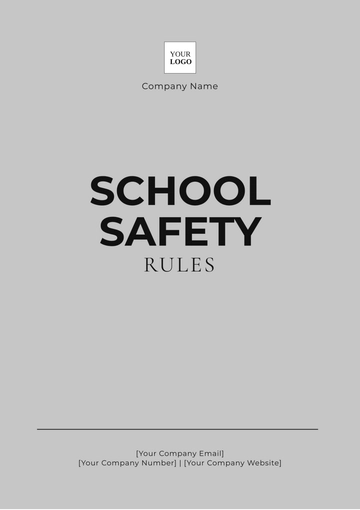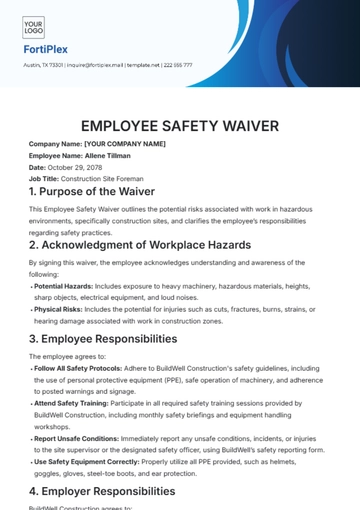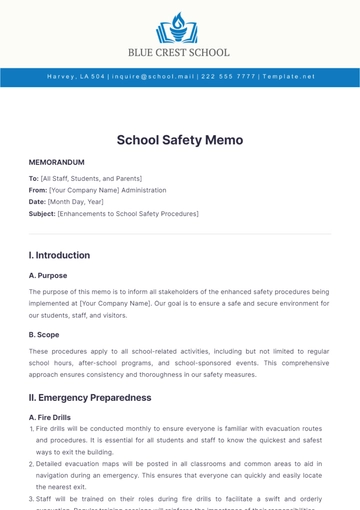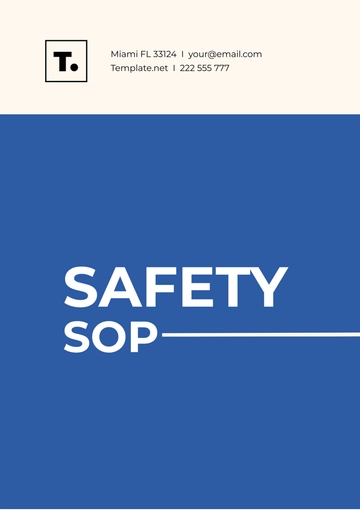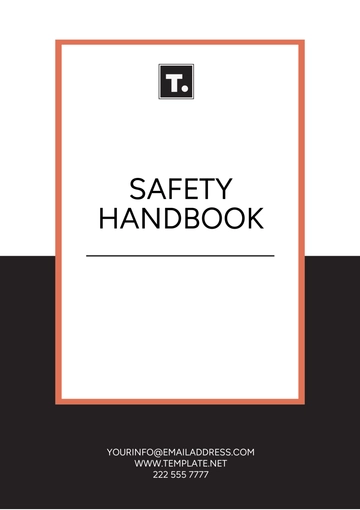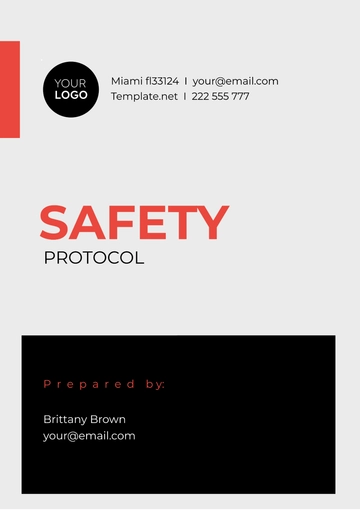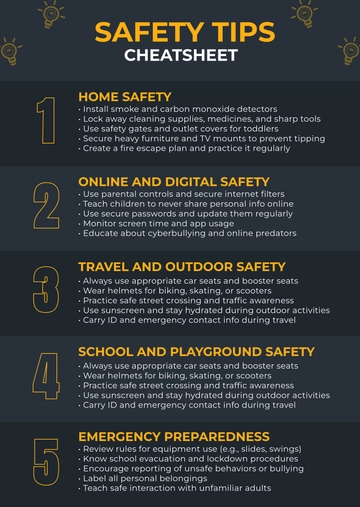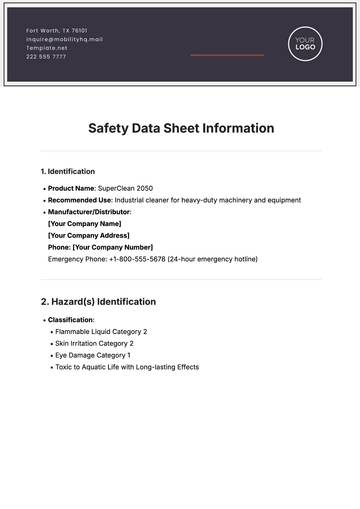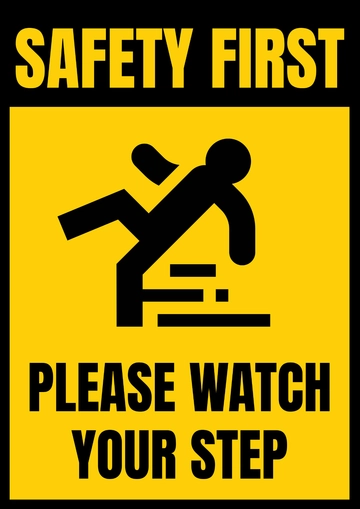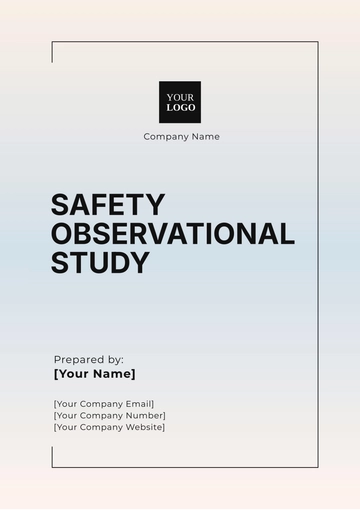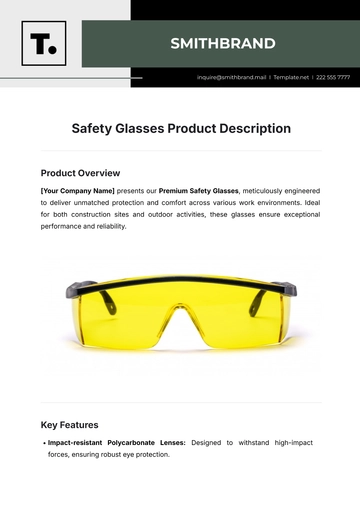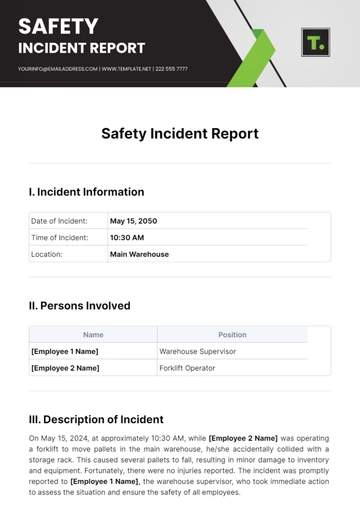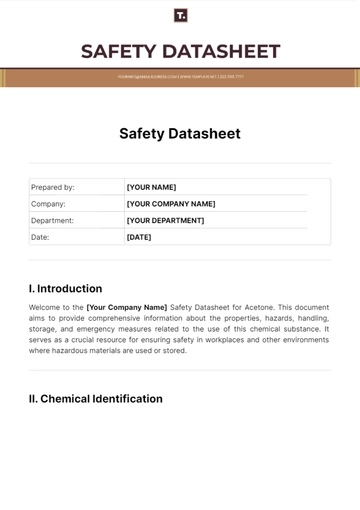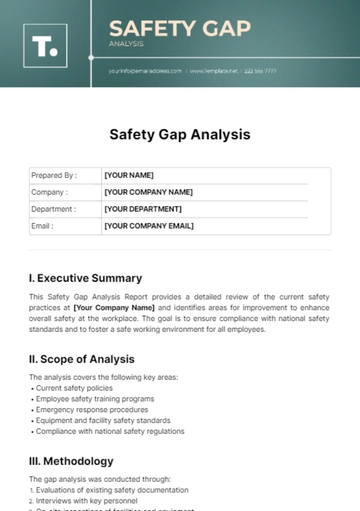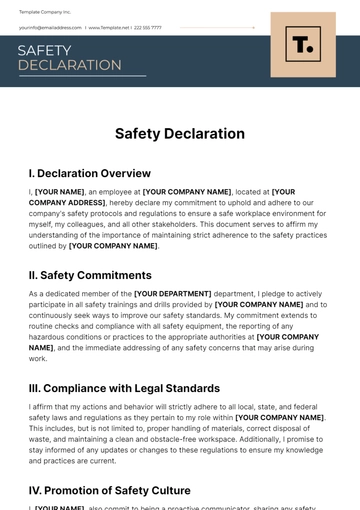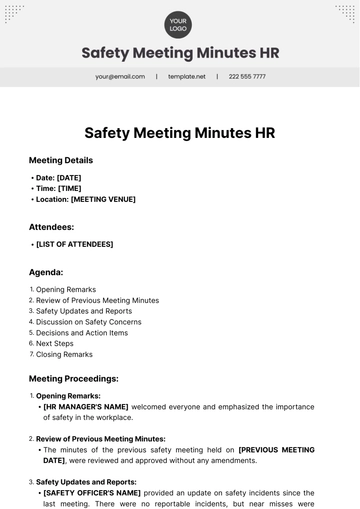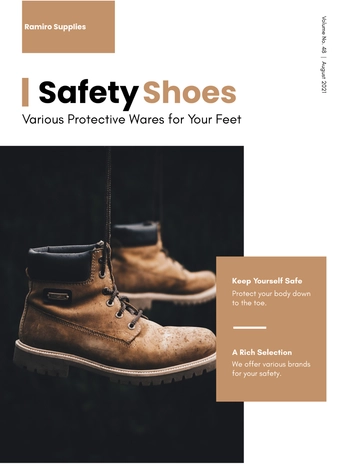Free Workplace Safety Guide

1. Introduction:
Welcome to [Your Company Name]'s Workplace Safety Guide. This document serves as a practical and comprehensive resource to ensure the safety and well-being of all employees within our organization. It outlines our commitment to maintaining a secure and healthy work environment, detailing the essential policies, procedures, and responsibilities necessary for a safe workplace. This guide focuses on practical steps and guidelines, emphasizing the importance of adherence to safety protocols and regulatory compliance. By following the information provided herein, we collectively contribute to a safe and productive work environment.
2. Health and Safety Policy Overview:
At [Your Company Name], our commitment to workplace safety begins with our Health and Safety Policy. This foundational document outlines the fundamental principles and objectives that underpin our safety initiatives. Its significance cannot be overstated, as it serves as our guiding compass in creating and maintaining a secure work environment.
The key principles of our Health and Safety Policy revolve around the protection of our most valuable assets: our employees. We prioritize accident prevention, hazard mitigation, and the continuous improvement of safety measures. Safety is a shared responsibility, and this policy emphasizes the active involvement and cooperation of all employees at every level of our organization.
Our objectives are clear and actionable. We aim to minimize workplace incidents, reduce occupational health risks, and ensure regulatory compliance. Through effective training, regular safety audits, and open communication, we seek to create a culture of safety that permeates every aspect of our operations.
This policy is the bedrock upon which our safety initiatives are built. It guides our decision-making, sets expectations for all employees, and demonstrates our unwavering commitment to ensuring that every member of our team returns home safely at the end of each workday.
3. Responsibilities and Roles:
In our commitment to maintaining a safe work environment at [Your Company Name], it is essential that every member of our organization understands their responsibilities and roles concerning workplace safety. By clearly defining these roles, we ensure a coordinated effort towards achieving our safety objectives.
The following table delineates the specific responsibilities and roles for employees, supervisors, and management:
Role | Responsibilities |
Employees | Adhere to safety protocols and procedures. |
Report hazards, near-misses, and incidents promptly. | |
Participate in safety training and follow safety guidelines. | |
Use personal protective equipment (PPE) as required. | |
Contribute to a culture of safety through proactive measures. | |
Support fellow employees in maintaining a safe workplace. | |
Comply with safety regulations and company policies. | |
Immediately report safety concerns to supervisors. | |
Supervisors | Ensure employees are adequately trained in safety measures. |
Enforce safety protocols and provide guidance as needed. | |
Conduct regular safety inspections and audits. | |
Investigate incidents and implement corrective actions. | |
Monitor and address safety concerns raised by employees. | |
Promote a culture of safety through leadership and example. | |
Management | Establish and communicate safety policies and objectives. |
Allocate resources for safety training and equipment. | |
Review and improve safety procedures regularly. | |
Ensure compliance with safety regulations and standards. | |
Support and empower supervisors in their safety roles. | |
Foster a company-wide commitment to safety excellence. |
These defined responsibilities and roles are crucial in creating a collaborative approach to workplace safety. Employees, supervisors, and management all play integral parts in ensuring a safe and secure work environment, and together, we can achieve our safety goals effectively.
By adhering to these roles and responsibilities, we uphold our commitment to prioritizing the well-being of every individual within our organization and maintaining the highest standards of safety.
4. Workplace Hazard Identification:
Identifying workplace hazards is a critical aspect of our commitment to safety at [Your Company Name]. This chapter explains the systematic process by which we identify potential dangers, encompassing physical hazards and health risks, and outlines the procedures for reporting them.
Hazard Identification Process | Details |
Observation | All employees actively observe workplace surroundings, including physical conditions, equipment, and unusual activities. |
Regular Inspections | Supervisors and safety officers conduct scheduled inspections, examining work areas, machinery, and materials for potential hazards. |
Risk Assessment | A formal risk assessment evaluates severity and likelihood of identified hazards, prioritizing which hazards to address first. |
Employee Input | Employees provide feedback on potential hazards encountered during work. Open reporting channels are essential. |
Types of Hazards | Description |
Physical Hazards | Dangers such as machinery, electrical equipment, confined spaces, and slippery surfaces should be identified and reported. |
Chemical Hazards | Crucial identification and labeling of hazardous chemicals. Awareness of chemical storage, handling, and disposal procedures. |
Biological Hazards | Risks may include exposure to infectious agents. Proper training and adherence to safety protocols prevent biological hazards. |
Ergonomic Hazards | Poor ergonomic conditions may lead to musculoskeletal issues. Employees are encouraged to report discomfort and seek adjustments. |
Psychosocial Hazards | Stress, harassment, and workplace bullying are psychosocial hazards. Employees should promptly report related concerns. |
Reporting Hazards | Action |
Employees | If an employee identifies a hazard, they should report it immediately to their supervisor, safety officer, or designated channels. |
Supervisors | Supervisors play a key role in hazard identification, ensuring prompt investigation, resolution, and mitigation of reported hazards. |
Safety Officers | Safety officers conduct detailed hazard assessments and coordinate corrective actions. They maintain records of identified hazards. |
Management | Management allocates resources to address hazards, ensures regulatory compliance, and fosters a culture of hazard reporting. |
5. Risk Assessment:
Risk assessments are a fundamental component of our commitment to workplace safety at [Your Company Name]. This section provides guidance on the systematic process of evaluating potential workplace hazards and prioritizing safety measures to mitigate these risks effectively.
The risk assessment process involves the following steps:
Step | Description |
Identify Hazards | Actively identify potential hazards in the workplace. |
Evaluate Severity | Assess the potential harm or damage that each hazard could cause. |
Determine Likelihood | Estimate the probability of each hazard occurring. |
Calculate Risk | Calculate the risk level by multiplying severity and likelihood. |
Prioritize Hazards | Prioritize hazards based on their calculated risk levels. |
Implement Controls | Develop and implement safety controls and measures for high-risk hazards. |
Monitor and Review | Regularly review and update risk assessments as needed. |
By following these guidelines and adhering to the risk assessment process, we proactively identify and address potential workplace hazards. This systematic approach empowers us to prioritize safety measures and minimize risks effectively, thereby fostering a safer work environment for all employees.
6. Safety Training:
Employee training is a cornerstone of our commitment to workplace safety at [Your Company Name]. This section provides a comprehensive overview of our training programs, encompassing orientation, ongoing training, and specialized safety training.
Employee Training Programs:
Program | Description |
Orientation Training | Provided to all new employees to introduce them to safety policies, procedures, and workplace hazards. |
Ongoing Training | Continuous training programs ensure that employees stay updated on safety protocols and regulations. |
Specialized Training | Tailored safety training for specific roles or tasks, addressing unique hazards and safety requirements. |
Our commitment to safety training is a vital component of our efforts to maintain a secure work environment. By equipping employees with the knowledge and skills necessary to identify and mitigate workplace hazards, we empower them to actively contribute to our safety culture. Safety training is an ongoing process that promotes a safer, more productive workplace for all.
7. Emergency Response Plan:
Safety extends beyond prevention; it also encompasses our preparedness and response to workplace emergencies. This section outlines the procedures for responding to a variety of workplace emergencies, including fire drills, evacuation plans, and first aid measures.
Emergency Response Procedures:
Emergency Scenario | Response Procedures |
Fire Emergency | Evacuation procedures and assembly points. |
Proper use of fire extinguishers and fire alarms. | |
Designated personnel responsible for emergency response. | |
Regular fire drills to ensure readiness. | |
Medical Emergencies | First aid stations and trained personnel. |
Emergency contact information and medical facilities. | |
Protocols for reporting injuries and seeking medical help. | |
Natural Disasters | Evacuation plans for earthquakes, storms, or floods. |
Emergency supplies and communication procedures. | |
Designated safety coordinators for each area. | |
Hazardous Spills | Immediate isolation and containment of the spill. |
Procedures for notifying emergency services and cleanup. | |
Personal protective equipment and evacuation if necessary. | |
Workplace Violence | Reporting mechanisms for threats or incidents. |
Safety measures, including lock-down procedures if needed. |
By outlining these emergency response procedures and ensuring that employees are familiar with them, we strive to create a safe and responsive workplace environment. Our commitment to preparedness equips us to handle workplace emergencies efficiently and protect the well-being of our employees.
8. Reporting Incidents:
Incident reporting is a crucial element of our commitment to workplace safety at [Your Company Name]. This section emphasizes the significance of incident reporting, provides guidance on reporting injuries or near-miss incidents, and outlines the documentation process.
Importance of Incident Reporting: | How to Report Incidents: | Key Reporting Principles: |
Early Intervention: | Injury Reporting: | Timeliness: |
Allows for immediate intervention to prevent further harm and address underlying issues. | In the event of a workplace injury, employees must report it immediately to their supervisor or manager. This report should include details of the injury, location, and any witnesses. | Reporting should occur as soon as possible after an incident or near-miss, ensuring that actions can be taken promptly. |
Near-Miss Reporting: | Accuracy: | |
Contributes to the identification of trends and patterns, enabling proactive safety measures to prevent future incidents. | Near-miss incidents, situations that could have resulted in injury but did not, should also be reported promptly. This proactive reporting helps identify potential hazards. | Incident reports should be accurate and truthful, providing a clear account of what transpired. |
Documentation: | Confidentiality: | |
Compliance with regulatory requirements often mandates incident reporting, ensuring adherence to legal obligations. | A formal incident report form is used to document all incidents. The form includes details about the incident, individuals involved, witnesses, and any corrective actions taken. | Information within incident reports is treated confidentially, respecting employee privacy. |
Follow-Up: | ||
Reporting incidents ensures that injured employees receive timely medical attention and support. | After reporting, investigations and corrective actions are taken as needed to prevent similar incidents. | |
Documentation: | ||
Detailed records of all incidents and corresponding actions are maintained. | ||
9. Safety Inspections and Audits:
This section provides insight into our safety inspection and audit procedures, emphasizing the importance of regular checks to ensure compliance with safety protocols.
Safety Inspection and Audit Procedures:
Procedure | Description |
Regular Inspections | Scheduled inspections conducted by trained personnel to identify and rectify safety deficiencies. |
Unscheduled Inspections | Unannounced inspections to maintain vigilance and prevent complacency in safety practices. |
Compliance Audits | Comprehensive audits to ensure compliance with regulatory requirements and internal safety standards. |
Hazard-Specific Audits | Focused audits addressing specific hazards or areas identified as high-risk. |
Documentation and Reporting | Detailed records of inspection and audit findings, including identified issues and corrective actions. |
Safety inspections and audits are vital components of our safety management system. These processes help identify potential hazards, ensure compliance with safety regulations, and reinforce our commitment to creating a secure work environment for all employees. By actively participating in these checks, we collectively contribute to a culture of safety and ongoing improvement.
10. Safety Equipment and Personal Protective Gear:
Safety equipment and personal protective gear play a pivotal role in safeguarding our employees at [Your Company Name]. This section provides comprehensive information on the proper use and maintenance of these essential safety tools.
Safety Equipment Usage:
Equipment | Usage Guidance |
Personal Protective Gear | Employees must wear appropriate gear for their specific tasks. |
Gear includes helmets, gloves, safety glasses, hearing protection, etc. | |
PPE should fit correctly, be well-maintained, and replaced as needed. | |
Fire Safety Equipment | Familiarize employees with the location and proper use of fire extinguishers and alarms. |
Conduct fire drills regularly to ensure employees can respond effectively. | |
First Aid Kits | Ensure that first aid kits are accessible and fully stocked. |
Designate trained personnel responsible for first aid assistance. | |
Emergency Evacuation Plans | Display evacuation plans prominently and ensure employees understand escape routes. |
Conduct evacuation drills to practice emergency response. |
Maintenance and Care:
Maintenance Aspect | Instructions and Considerations |
PPE Inspection | Conduct regular inspections to identify wear or damage. |
Replace damaged PPE immediately. | |
Fire Safety Equipment | Ensure that fire extinguishers are in working condition. |
Schedule regular maintenance and testing of fire alarms. | |
First Aid Kits | Assign responsible personnel to check and restock kits. |
Check expiration dates on medical supplies and replace as needed. | |
Equipment Training | Provide training on the proper use of safety equipment. |
Ensure employees understand the significance of each piece of equipment. |
11. Compliance with Regulations:
Compliance with local, state, and federal safety regulations is not just a legal obligation but a fundamental aspect of our commitment to workplace safety at [Your Company Name]. This section underscores the significance of adhering to safety regulations and outlines the measures we take to ensure compliance.
The Importance of Compliance:
Legal Obligation: Regulatory compliance is mandated by law, and failure to comply can result in legal consequences, fines, and penalties.
Employee Safety: Compliance with safety regulations prioritizes the well-being of our employees, reducing the risk of accidents and injuries.
Reputation: Demonstrating commitment to safety compliance enhances our company's reputation as a responsible and reliable organization.
Ensuring Compliance:
Regulatory Review: We maintain a dedicated team responsible for staying updated on local, state, and federal safety regulations relevant to our industry.
Documentation: Detailed records of safety-related documentation, including permits, licenses, and certifications, are meticulously maintained.
Training: Employees are regularly trained to ensure awareness of and adherence to safety regulations specific to their roles.
Audits and Inspections: Internal and external audits and inspections are conducted to assess compliance levels and identify areas for improvement.
Corrective Actions: Any identified non-compliance issues are addressed promptly through corrective actions, which may include process changes, additional training, or equipment upgrades.
Continuous Monitoring: We continuously monitor changes in safety regulations and adjust our procedures accordingly to remain in compliance.
Reporting: All incidents of non-compliance are documented, reported, and reviewed to prevent recurrence.
By emphasizing compliance with safety regulations at all levels of our organization, we not only meet legal requirements but also foster a culture of safety and responsibility. Our commitment to compliance contributes to the safety and well-being of our employees and ensures that we operate ethically and responsibly in all aspects of our business.
12. Safety Communication:
Effective safety communication is a cornerstone of our commitment to maintaining a safe work environment at [Your Company Name]. This section provides a comprehensive overview of the methods we employ for safety communication within the organization and the reporting channels available for safety concerns.
Safety Communication Methods:
Communication Method | Description |
Meetings | Regular safety meetings are conducted to discuss safety updates, concerns, and share best practices. |
Training Programs | Safety training programs educate employees on safety protocols, emergency procedures, and hazard recognition. |
Safety Policies | Clear and accessible safety policies are provided to all employees, outlining expectations and procedures. |
Notices and Signs | Safety notices and signs are strategically placed to communicate specific safety information and warnings. |
Safety Committees | Safety committees consisting of employees and management are formed to facilitate safety discussions and initiatives. |
Safety Reporting | Employees are encouraged to report safety concerns, incidents, and near-misses through designated reporting channels. |
Employee Feedback | Employee feedback mechanisms are established to collect suggestions and input on safety-related matters. |
13. Conclusion:
Safety is at the heart of our operations at [Your Company Name]. We are committed to fostering a culture of safety that prioritizes the well-being of our employees and ensures compliance with regulatory requirements. By actively engaging in safety training, inspections, and communication, we collectively contribute to a secure work environment where everyone can thrive. Our dedication to continuous improvement in safety practices reinforces our commitment to excellence, and we remain vigilant in our efforts to identify and address potential hazards. Together, we create a workplace where safety is not just a goal but a fundamental value that guides our actions and decisions every day.
- 100% Customizable, free editor
- Access 1 Million+ Templates, photo’s & graphics
- Download or share as a template
- Click and replace photos, graphics, text, backgrounds
- Resize, crop, AI write & more
- Access advanced editor
Discover unparalleled workplace safety guidance with our exclusive Workplace Safety Guide Template, meticulously crafted by Template.net. This editable and customizable tool empowers you to tailor safety protocols to your organization's unique requirements. Seamlessly modify and refine with our Ai Editor Tool, ensuring a comprehensive and adaptable safety framework.
